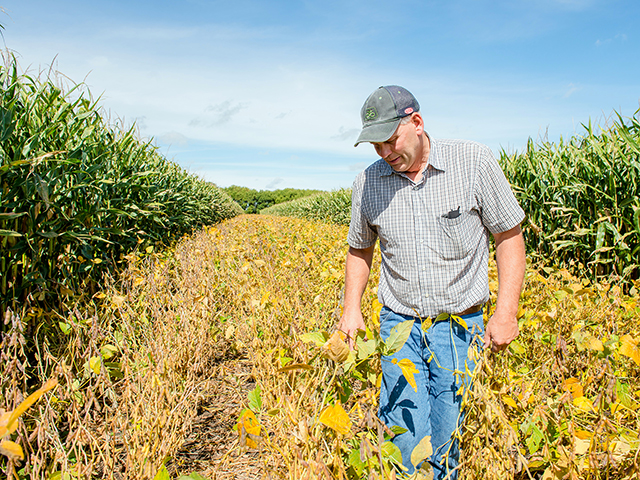Overcome Soil-Health Obstacles
Soil Health - Overcome Soil-Health Obstacles
Heavy, flat and black soils that Dean Sponheim farms in far north-central Iowa, according to local wisdom, are not supposed to produce good yields without conventional tillage.
Sponheim has also been told by some neighboring farmers that cover crops can't be adequately implemented into cropping systems because of the region's climate and shorter growing season.
Both assumptions, the Nora Springs farmer says, are false.
Sponheim started strip-tilling corn in 1999 to eliminate soil-crusting issues and subsequent replanting in a few wet fields. It worked so well, he quickly adopted the practice over every acre. He switched to no-till soybeans and eventually adopted cover crops and strip-cropping to gain soil-health benefits.
"When you do these types of practices, you need patience," Sponheim says. "For corn, it took about four years for the ground to switch. [Soil] organisms took over and started decaying the residue."
He was one of four farmers who participated in a panel discussion during a recent two-day virtual University of Minnesota Soil Management Summit. The farmers, along with tillage and social science specialists, discussed ways to increase adoption of soil-health practices.
Sponheim earned the 2020 Environmental Leader Award from the Iowa Soybean Association, but he first adopted conservation practices for economic reasons. Strip-till and no-till reduced input costs without sacrificing yield, he contends. Neighbors took notice and asked for help. He now operates custom strip-till and cover-crop businesses.
"I can almost guarantee to a first-time customer that we will initially retain yields when we start strip-tilling," Sponheim asserts. "Give me four or five years, and we will increase yields tremendously with the same inputs or less."
Cover crops such as cereal rye increase soil tilth, suppress weeds and build organic matter, he continues. His goal is to eventually eliminate herbicides using only cover crops for weed management.
Sponheim notes he's had issues in the past where cover crops reduced yields, but the benefits outweigh the risks. He suggests that farmers who are considering soil-health practices seek advice from others who have adopted them.
"I'm not going to say we never made mistakes, because we have," Sponheim adds. "Glean knowledge from people so you don't make the same mistakes."
NEW APPROACH
Advocates such as Sponheim agree a different approach may be needed to get more farmers and landowners to try and increase the adoption of soil-health practices.
P[L1] D[0x0] M[300x250] OOP[F] ADUNIT[] T[]
J. Gordon Arbuckle, a sociology professor at Iowa State University (ISU), says research overwhelmingly shows cover crops, no-till and reduced tillage, as well as other conservation practices, improve soil health. And, for the most part, farmers agree healthy soils are more productive.
While adoption of many soil-health measures is on the rise nationwide, implementation falls far short on the majority of principal crop acres. After assessing two major literature reviews, studies and focus groups on the subject, Arbuckle is convinced a holistic approach is needed to get farmers and landowners more excited about ways to improve soil health.
"We [researchers and Extension officials] often focus on talking about the benefits of [cover crops and soil-health] practices, but I think it's actually more important to talk about risk management," he contends. "Farmers understand the benefits, but those perceived risks oftentimes keep farmers from giving the practices a try."
Arbuckle's research focuses on improving the environmental and social performance of agricultural systems.
COMPELLING DATA
Cover crops, conservation tillage and no-till, and extended crop rotations help build resilient soil. Collectively, the practices mitigate soil erosion and nutrient loss, improve soil structure and organic matter, increase water infiltration and holding capacity, and reduce compaction.
Arbuckle says 93% of farmers who participated in past Iowa Farm and Rural Life Polls strongly agree/agree that healthy soils increase yields. Seventy-seven percent of farmers strongly agree/agree that healthy soils can increase drought resilience. And, 75% of farmers strongly agree/agree that healthy soils can reduce input needs. Arbuckle indicates results in other Midwestern states would likely be similar.
Nationally, farmers increased cover-crop acreage by 50% between the USDA's 2012 and 2017 Census of Agriculture, going from nearly 10.3 million acres to nearly 15.4 million acres. But, 317 million acres were planted to corn, soybeans, sorghum, wheat, barley, rice and oats in 2017.
No-till totaled nearly 105 million acres in 2017, up about 8 million acres from 2012, according to the Census of Agriculture. Reduced tillage increased more than 20 million acres during the same time period, to nearly 97.8 million acres in 2017.
ADOPTION BARRIERS
Perceived risks of farmers inhibit widescale adoption of soil-health practices such as cover crops and no-till, Arbuckle believes. Based on reviews of social science research, he says those alleged risks include:
> yield loss to principal crop
> moisture worries (Cover crop may use too much water.)
> lack of time (not getting cover crops planted or terminated in a timely manner or getting fieldwork completed)
> weed issues
> cost.
Jodi DeJong-Hughes, a University of Minnesota regional educator specializing in tillage-management systems, says educators and farmer advocates need to express the benefits and challenges of cover crops and other soil-health practices equally.
"If we just go out and say how great everything is, and then something fails, it doesn't give us much credibility," she continues.
DeJong-Hughes believes farmers with in-depth knowledge of cover crops and soil-health practices are often the best people to convey information.
**
FOR MORE INFORMATION:
> Watch a video of Sponheim talking about soil health at
www.youtube.com/watch?v=63CeHb3ADmA
> Follow Matthew Wilde on Twitter @progressivwilde
[PF_0421]
(c) Copyright 2021 DTN, LLC. All rights reserved.



